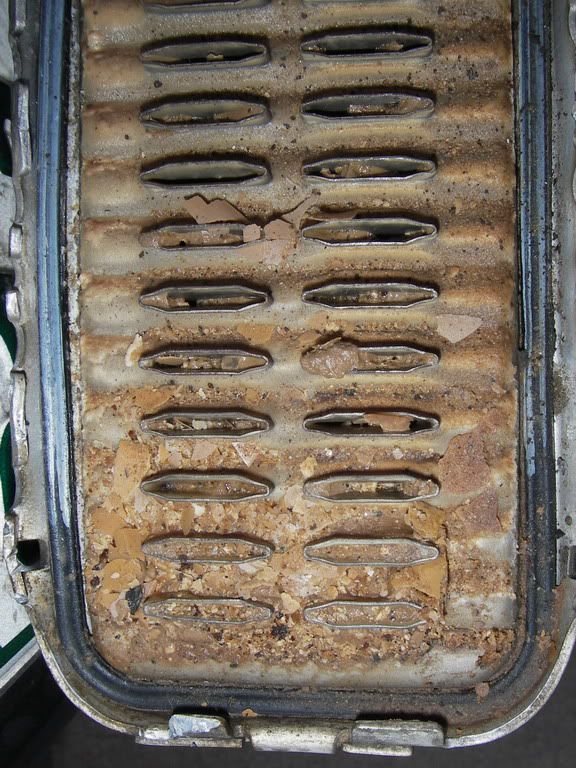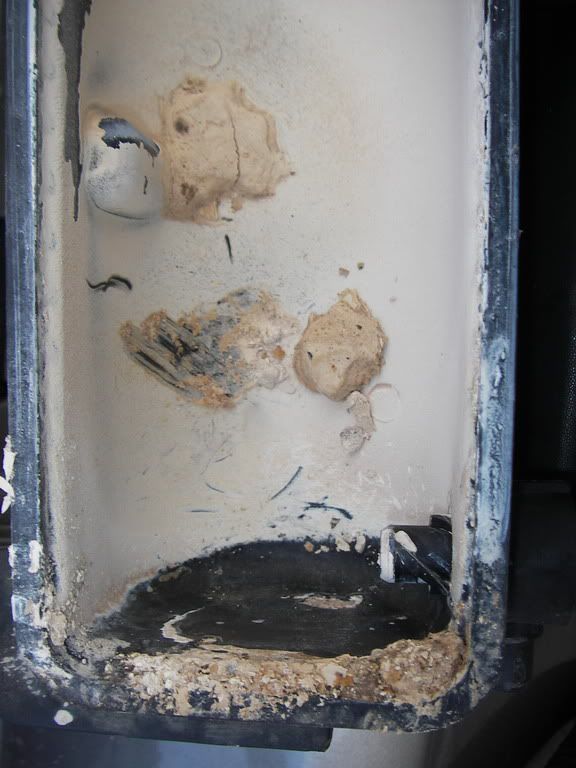I've read through tons of posts, how-to's, and back-and-forth discussions here regarding HOAT coolant, CRD cooling problems and the when's/why's & how's of flushing these bizzarre systems we've got. But, I've not seen anything specific about a system as dirty as mine. Check out the photos at the end of this post.
Sorry that this is such a long post, I haven't found any others with problems just like mine, and I thought someone out there might want to see some of this. The specific questions that I have are highlighted in blue. If I've missed a helpful thread somehow - please, someone point me to it. Otherwise - here we go:
Summary - 2005 Liberty CRD, 94,000 miles.
Initially in the summer, I noticed car overheating under load (mostly on mountain roads - uphill). Gauge would nearly top out, but pulling over or heading downhill would cause gauge to immediately drop back down to normal. Driving around town, the car performed fine.
When winter came around, I started noticing that it would take forever for the motor to warm up (according to dash gauge), and cabin heater output was ice cold.
At this point, I mistakenly thought that the viscous clutch was bad because the fan would free spin, regardless of what the temp gauge was reading. Even with the radiator blocked off, the fan would still spin easily. (Turns out that it probably wasn't bad - the radiator just wasn't releasing enough heat to make the clutch engage).
Replacing the fan clutch made a little difference, but not much.
Next I replaced the thermostat, thinking it was partially stuck. My scanner would tell me that the ECT was at about 160 - untill I hit a sizable hill. Then it would climb rapidly. After replacing the t-stat, most of the symptoms remained, except the motor would warm up quicker, and to a more normal temp. (By the way - the thermostat
was stuck partially open).
I have to note that the top radiator hose was always hot to the touch, making me think that I was getting flow from the water pump. (now that I compare it to the hose on my other CRD - I realize it was maybe not
as hot)
Next I notice on the metal lines going to the heater core - one is too hot to touch, the other barely warm.
BTW - am I correct in saying that there is no heater control valve, only a blend door to control heat output. Heater core should be getting full flow always. Therefore all the posts and the FSM stating that the heater should be "full on" when flushing (or turned off to keep scale out of the heater core) are incorrect?I take the car to a pretty decent diesel tech who does a full cooling system diagnosis and checks the head gasket. It was he that pointed out that the radiator was ice cold regardless of t-stat, dash gauge, etc. He suggested that the radiator must be partially clogged. Also suggested that I try flushing the heater core.
I disconnected hoses going to heater, attach some lengths of 5/8" garden hose with various fittings, a funnel, etc.... and poured in some diluted radiator cleaner. Let it sit about 10 minutes. Backflushed under pressure. Repeated 3 times. Running the output hose into a clean bucket - I was able to catch quite a bit of crap. Looked mostly like sand with a few black flakes that looked like paint from the inside of a fitting or something. Hooked it all back up, burped the bubbles. Heater worked great, even when the viscous coolant heater wasn't engaged.
Took the car to a different shop that has the proper flushing equipment. Showed my little bottle of gunk, talked about symptoms. System was supposedly flushed, said he was getting flow. (Although, I'm not sure how much - see photos below).
After this, feeling that the radiator was still cold, I decided to start tearing into it. Starting with the radiator and working back to the water pump if necessary. It took about 4 hours to get the radiator and hoses out - dealing with the fan/clutch (again), shroud, radiator support, charge air cooler, airbox, battery, etc.
At this point, I have to ask: has anyone else had the trouble that I had getting the radiator out? It's not as simple as the FSM makes it out to be. The charge air cooler (which is also indirectly fastened to the a/c condensor) is hooked on to the front of the radiator with interlocking tabs. Which means in order to lift the radiator high enough to disengage the plastic pegs that drop into the grommets in the frame - I had to remove the grill, remove the hood latch support, take the electric fan loose, then push up the whole mess and prop it in position with some chunks of 1x2 under the CAC. Only then could the radiator be lifted high enough to disengage the bottom end. Anyone else run ito this?So anyway, after wrestling the radiator out and pointlessly peering into the various holes - I stuff a garden hose into the outet and turn it on full blast. Seeing more water coming back out at me than out of the other end, I toss the the radiator into the back of the other Libby and drive 25 miles to the nearest radiator shop. He does a flow test, then soaks it overnight in some kind of aluminum-safe cleaner, attempts another flow test in the morning - then calls me, anxious to cut the tank off to see just what could be plugging this thing so solidly. So we're looking at it together with the inlet tank off, talking about the evils of HOAT coolant, and the whole while he's pushing one of his skinny flat rods into different tubes - I don't think he was able to push all the way through any of the tubes except for maybe just a few.
This guy's been in business since the 70's and claims he's never seen one like this. Especially on a car that's only 5 years old.
So, is this what the HOAT coolant does? I'm thinking that sometime in the last 5 years, when this Jeep was mostly driven by my son - that maybe someone who did an oil change also did him the "favor" of topping off the coolant level with something wrong? Or maybe even some dipstick mechanic at the Jeep dealer when they did one of the three EGR replacements that have been done.
In the pictures below - could the stuff be some kind of leak sealer maybe?
When I took the now dis-assembled radiator back to the shop that did the system flush - he tells me that it looks to him like it's casting sand that was left in the block.
So now, as I sit in Colorado, waiting on a radiator coming from Detroit via Tampa, I'm wondering what I should do about flushing the system out before I put the new radiator in? The guy who thinks the mystery material is sand claims that it's probably
all in the old radiator now, and I don't need to do anything radical as far as flushing goes. Says it will go
another 100,000 miles. But then again, this is the same mechanic who
thought he was getting flow through the radiator when he "flushed" the system!
Anyone with any advise - please jump in. Otherwise, my plan is this:Once the radiator and hoses arrive, (providing we've got no sub-freezing weather coming) I going to take the garden hose with a pressure nozzle, hook it up to my water heater, and spray into any and every hose, port, etc that I can access. I'm leary about trying to use any type of chemical cleaner (trying to fill the block, hoses, viscous heater, etc) because I know it's gonna take 3 - 5 hours to get everything reassembled, and I don't want any residual cleaner sitting that long anywhere in the system.
Is there anything in the system that might be damaged from this flushing with garden-hose pressure?After every thing is connected I'll do several fresh water flushes till I (hopefully) get clear water draining out. Then, blow out whatever I can with the shop-vac trick. Then probably a couple more flushes with distilled water. Then a refill with Zerex G-05 diluted 50/50 with distilled water.
Any special additives that ought to go in the tank?Before I do all the freshwater flushing - should I use a chemical cleaner after the system is up and running? I really don't want to knock anything loose that's gonna plug up the new radiator. Who knows how much crud is lurking in the block, viscous heater, etc. And since I'm not sure what the gunk is - I don't know what it would take to disolve it, or if it even can be disolved. Some of the stuff truly
does look & feel like fine casting sand. But there's also some shiny little flakes and some globs of stuff. Note - I took the pix a couple of days ago when the radiator was still damp, having just come from the radiator shop. Now everything has pretty much dried to the same consistancy - soft crumbly powder.
I'll probably take the old radiator and bandsaw it into chunks today and see if I can soften up the crud with some various solutions.
I'm thinking maybe I'll do the citric acid flush - any reason that I shouldn't? I've already resolved myself to the possibility of having to remove the radiator again after flushing and having it back-flushed at the radiator shop if necessary.
Should there be any reason to get into the water pump at this time? I'm pretty sure that the root of the evil is the plugged radiator, but......? I'm planning to do the whole timing belt/idler/WP thing on both CRDs this summer when it's a bit warmer. I assume that the pump is working since I'm now getting heat in the cabin and can see flow through the overflow tank.
Any advice will be greatly appreciated. I'll post more info as I get results.
Doug

Most of the tubes of the radiator are plugged solid

The entire inside surface of the radiator end tank is coated with a thin layer of pinkish white powder. There's also some big mounds of this substance stuck in various places. They break off easily and crumble to dust. You can also see a pile of goo that had collected in the bottom of the tank. I wonder how much of this stuff in collected in the various nooks and crannies of the cooling system?



